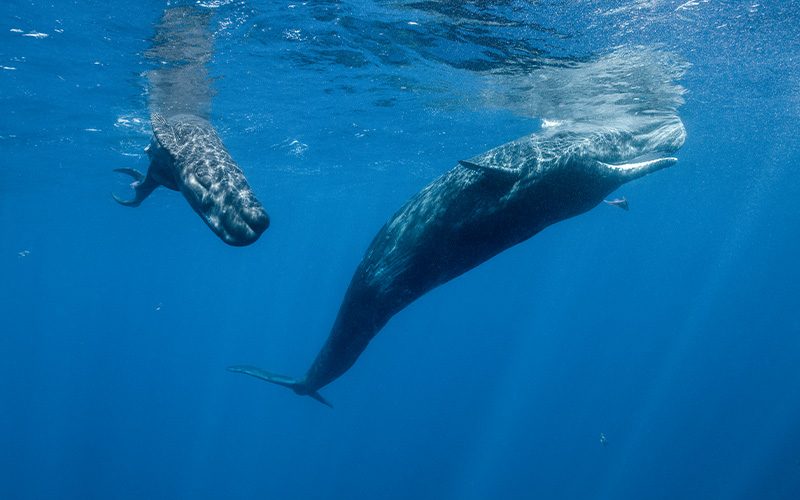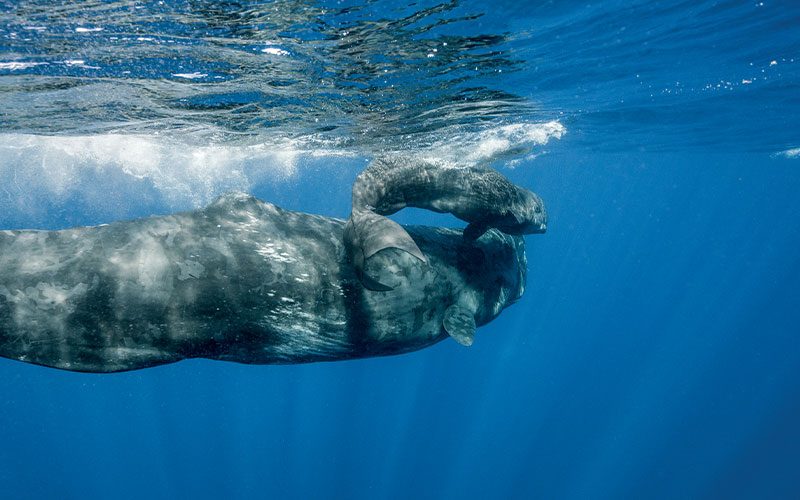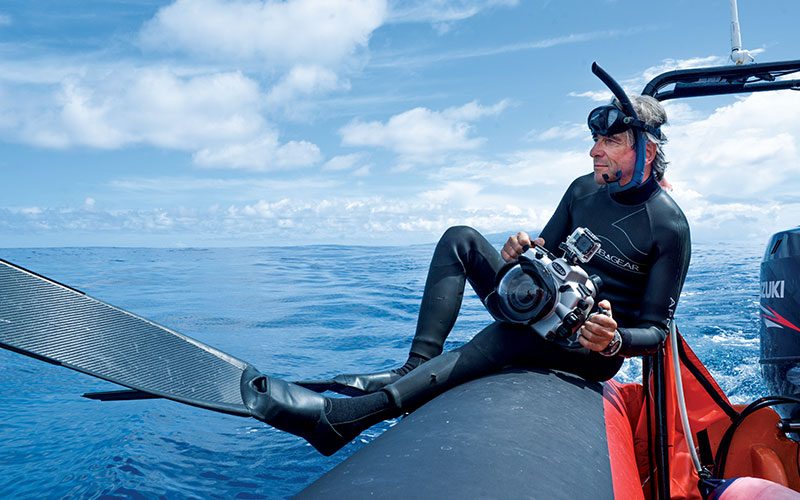American whalers came to the Azores, off the coast of Portugal, in the early 19th century. Although they didn’t initially operate in these waters, the islands were used for provisioning and supplementing crews with energetic young men from the archipelago. In time, Azoreans took up whaling themselves, establishing their own whaling stations along the coast.
Whaling in the Azores significantly declined in the 1970s and officially ceased with the International Whaling Commission (IWC) ban in 1986. In its stead, a lucrative new business has arisen: Now visitors hunt whales with photo and video cameras rather than harpoons. This is what brought me to the Azores.
For five days we cruised the islands of Faial and Pico. Nine hours a day in a small boat gets long and tiresome, but it’s necessary for close encounters with the giant sperm whales of the Atlantic.
Both technically and physically, sperm whale photography poses some of the greatest challenges to the underwater photographer. In addition to being extremely shy, sperm whales use echolocation to detect sound and movement for up to several miles. To avoid scaring them away with engine noise and scuba bubbles, boats must remain far from the whales, and freediving is the most practical way to approach them.

The day started promisingly with three sightings and an underwater encounter to within about 65 feet. From a small boat like the one we used, it is not possible to see whales from the surface. Therefore, we worked with vigias da baleia — people who watch for whales from hillside observation towers, remnants from when commercial whaling was still practiced in the Azores.
Centuries ago Azoreans constructed lookouts high above sea level on several of the islands. From these vantage points they used binoculars to spot their quarry and communicated the locations to the whalers with smoke signals, rockets and eventually radios. These observers were the most important men in the Azorean whaling trade, as only they could direct whalers to their targets. The local whalers were generally fishermen, craftsmen or farmers who dropped what they were doing when a whale was spotted. The cry “Baleia! Baleia!” would send them running to the harbor, where their boats — at first slender rowing boats called canoas, evolving to motor boats by the second half of the 20th century — were always ready to set out.
Our boat’s radio suddenly crackled, and from the driver’s reaction I could tell it was a good message. A group of about six animals had been spotted about one nautical mile to the south.
Courtesy of twin 150-horsepower motors, we reached the spot quickly and saw our quarry. The pod was swimming in circles very slowly — a decidedly strange behavior. We cut the motors to avoid scaring them away, and we kept to a safe distance of about 100 yards. With a last look at the pod’s position, I gently slid into the water.
For the first 60 yards I swam as fast as possible, scanning the blue to try to glimpse the animals, but there was nothing but a big murky cloud. I soon realized that the cloud was blood, which appeared greenish because of the loss of red light underwater. This explained the pod’s strange behavior. I thought they must be watching over a wounded member.
Female sperm whales are famously social. They form networks with their young and live in groups of 15 to 20 animals. Sexually mature males leave the pod and form associations with older males but travel alone. I assumed (correctly, it turned out) that this was a pod of females.
As the whales’ communication sounds intensified, I could make out the group about 20 yards away, huddled just below the surface. But with the sun directly in front of me it was difficult to see exactly what was going on.

I descended to 50 feet to carefully pass beneath them. My descent revealed that my initial assessment was wrong: There was no wounded animal; it was a mother giving birth. The placenta and bits of skin were floating in the water around the calf, which had left the womb only seconds earlier.
Even at birth, sperm whales break all records for toothed whales: A baby can weigh more than a ton. Bulls can reach a length of 60 feet and weigh more than 40 tons; they are the biggest toothed predator and have the largest brain of any animal. Despite these impressive statistics, newborn sperm whales remain relatively helpless. Unable to swim in the first minutes of life, an infant sperm whale relies on a group of females to help it enter the world.
Five midwives floated the still-immobile newborn to the surface to take its first breath, while the mother, still weak from birthing, watched from below. With every passing minute the calf became increasingly mobile until it could swim independently for short distances. I heard its communication, which had a higher pitch than the others — like the voice of a child.
To avoid disturbing the animals I moved carefully and maintained a distance of about 30 feet. Up to this point the whales had not noticed my presence, but suddenly the mother wanted to identify the stranger in their midst.
Quietly but directly, the 30-foot-long giant turned in my direction and swam right up to me. Her massive head got bigger and bigger as the displaced water pushed me away. Water churned around me as the noise of her exhalations thundered in my ears. I saw her eye looking at me, and I discerned no aggression at all.

Sperm whales are stocky, and their characteristic bulbous heads can account for up to a third of their total length. Researchers believe that the whales’ heads serve as “acoustic lenses,” focusing sound waves sent out during echolocation. Emitting high-frequency clicking sounds, the animals scan the surrounding environment and are able to image a large area.
Whales communicate perpetually and are audible to others over great distances. As the birth was communicated, more and more animals arrived for the event. As the giants congregated, I realized that I was fully accepted.
The mother swam to the other groups of whales to present her child. Incredibly, she even did the same for me, stopping and allowing the baby to swim toward me. After about 20 minutes, the baby was already stronger and faster — and eager to venture away on its own, which the mother did not like at all. Using her immense, toothy mouth, she brought her little runaway back to the surface.
As the event came to its conclusion, the whales disappeared into the blue of the Atlantic, while the mother descended with her child into the depths.
Sperm whales swim in all oceans. They’re most commonly found in the tropics and subtropics, but they also explore colder seas. In 2004 a sperm whale was even spotted in the Baltic Sea for the first time.
The average dive time for a sperm whale is 45 minutes, but some may extend up to 120 minutes. How it’s possible for sperm whales to hold their breath for such extended periods has not yet been fully explained, but it is known that they are able to restrict and slow their metabolism to a minimum while diving, during which time blood is directed only toward essential organs such as the heart, brain and spinal cord.
Unfortunately, these hearty and majestic animals are still in danger. Commercial whaling continues by some countries — notably Japan, Norway and Iceland — that found loopholes or declared an objection to the IWC’s ban, resulting in the death of thousands of whales each year.
In my 45 years of underwater photography, I have documented many spectacular and unique situations, but this experience provided the single most powerful encounter of my life. I hope my images will spread awareness and encourage people to support the protection of these intelligent and endangered marine mammals.
Note: The government of the Azores authorized Kurt Amsler´s interactions with the sperm whales, and he took every precaution to not disturb the animals.
Explore More
© Alert Diver — Q3 Summer 2015